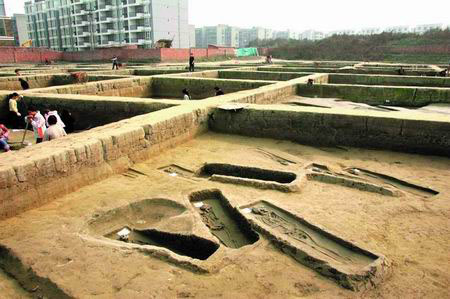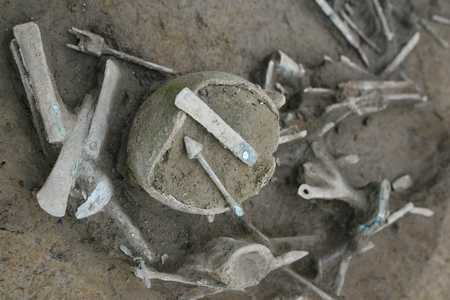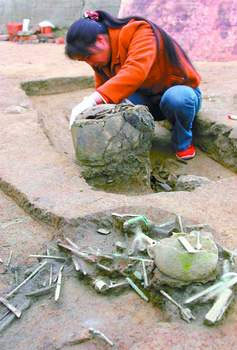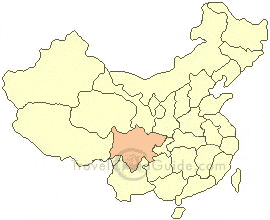
Posted on 04/04/2007 4:27:39 PM PDT by blam
3000 Year-old Jinsha Coming to Life
The archeological site of Jinsha located in the western suburbs of Chengdu, the capital city of Sichuan Province, is widely believed to have been the capital of the Shu Kingdom close to 3,000 years ago. After some burial grounds and sacrifice emplacements were recently discovered, a renewed effort was made to excavate Jinsha. This vigor has now revealed the outlines of the cemetery, living areas, palace remains and sacrifice grounds.
Lying only 50 kilometers away from the famed Sanxingdui, Jinsha rose to prominence around 1000 BC and shared similar origins with Sanxingdui as can be seen from similar burial objects although unlike its hallowed neighbor, Jinsha had no city wall. So far, artifacts made from ivory, jade, bronze, gold and stone have been found at the site.
Sanxingdui flourished from 3000 BC to about 800 BC, markedly earlier than Jinsha culture. Due to this, some historians have theorized that Jinsha's culture and influence succeeded Sanxingdui's after the latter was brought low by natural disasters.
Over 800 tombs found

So far, over 800 tombs have been found in the Jinsha ruins, stretching back from the middle of Western Zhou Dynasty (c. 1100 BC - c. 771 BC) through to the early Spring and Autumn Period (770 BC - 476 BC).
Experts revealed the complete excavation of the 1,000-square-meter palace area lying to the north of the site, next to the religious ceremony ground to the northeast. The residential and cemetery areas took up the central parts of the site. The diameter of Jinsha, at its apogee, would have comprised 5 square kilometers and the individual functionality of different areas speaks of the fairly high level of development attained by the city.
Upon investigation, it was found that all the tombs faced a southeasterly direction and DNA testing has revealed that all the excavated corpses had been less then 30 years old at the time of their death, a fact attributed to frequent warfare.
Each skeleton was surrounded by potteries and jade objects. An oddity when looking in ancient funerary customs is the presence of a jade knife in each body's chest, a very rare custom for the time.
Another rarity was discovered when a tomb was found to contain two skeletons, buried side-by-side. Soil samples revealed that the area was turned from a living area into a cemetery although archaeologists are baffled as to why.
Special tomb No. M1901

According to specialists, the entire tomb area has been wholly excavated, with the exception of tomb M1901, on which excavation work began at the end of March.
Zhang Qing, director of the Chengdu Municipal Cultural Relics and Archaeology Institute's Jinsha Site Archaeological Station, explained that "when we first found this tomb, we noticed it was different from the others -- it's larger than those surrounding it, being 2.5 meters in length and 1.4 meters in width. It contains peculiar articles, unlike those in other tombs. Most of the bodies in Jinsha were well-preserved but the one in M1901 was burned before burial, something very rarely seen." Zhang surmised that this represented an ancient sacrificial ceremony in which leaves and other objects were set ablaze on the body of the deceased.
With the knowledge they now hold and although they cannot pinpoint the person's identity, archaeologists can reveal that this tomb did not contain a commoner but is also too small to have contained the remains of a prince or nobleman. Thus, Zhang explained, the man may well have been an ancient sorcerer or respected artisan.
Sorcerers conducted all of Jinsha's sacrificial ceremonies and by the luxurious items found in the sacrificial areas of Jinsha, it can be seen that sorcerers were held in high esteem.
The other conjecture is that the unknown man could be a high-level craftsman, who were highly praised at the time for their unique skills, Zhang explained.
Experts will now use "carbon 14" dating test to determine the precise age of the M1901 skeleton and his tomb.
Rare bronzewares

Altogether 74 bronze items of high quality were uncovered in the No.M1901 tomb, the first such find during the six-year excavation of Jinsha. These items were all miniature weapons or tools such as knives, arrows, arrowheads, shovels, forks and axes, measuring about 10 centimeters in length.
Archaeologists were originally baffled as to whether these were ornaments, toys or served another purpose. For his part, Zhang held the belief that these articles were simply funereal objects which served as a status symbol for the deceased they accompanied.
Besides these miniature tools, other crossed bronze artifacts were unearthed, with the particularity of having been cast in a wholly original manner for the time.
"Ancient people of Jinsha had discovered a new method of casting bronze, known as piece-mould casting method. A model of the object to be cast was first made and turned into a mould. The mould would then have sections cut away from it to release the original model. The sections would then be individually strengthened with fire before being reassembled to form a solid mould ready for casting. If the object to be cast was a vessel, a core would be placed inside the mould to ensure the vessel's cavity," Zhang Qing explained.
Jade chisel

The excavation of tomb M1901 was to provide yet another interesting turn of events. As workers thought they had fully explored the tomb and were preparing to evacuate it, they moved an earthen jar revealing a transparent piece of jade beneath it. According to Zhang, the new item is a jade chisel, used to work on wood or bamboo, and was also a symbol of death used in sacrificial rites.
The jade chisel, measuring around ten centimeters long and in good condition, is the second of its kind in the Jinsha Ruins. Its discovery will be highly valuable in providing research on sacrificial vessels of the time.
3,000-year-old bark-roofed house
The ruins also revealed remains of houses. Ancient houses were worn down to their foundations when archaeologists arrived but the humid climate around Chengdu allowed the wooden frames and bark roofs to be partially preserved, explained experts.
One house had covered around 30 square meters, with a roof wholly made of bark measuring 7 by 3 meters. After analyzing the wood, the house was thought to have been built towards the end of the Shang Dynasty (c. 1600 BC - c. 1100 BC).
(China.org.cn by Chen Lin, April 3, 2007)
Treasures Of Sanxingdui

The site of Sanxingdui, located in the city of Guanghan, 40 km from Chengdu, Sichuan Province, is recognized as one of the most important ancient remains in the world for its vast size, lengthy period and enriched cultural contents. The first Sanxingdui relics were discovered by a farmer in 1929 and excavation has continued ever since. During this period, generations of archaeologists have worked on the discovery and research of the Sanxingdui culture. In 1986, two major sacrificial pits were found and they aroused widespread academic attention around the world. The Sanxingdui finds are exciting, but they remain enigmatic. No texts have been found, nor is there any mention of this culture in the records of other countries. Analysis of lead and other elements in the bronzes indicates sources similar to those of other cultures along the lower reaches of the Yangtze River. At this point, however, the unique culture that produced these artifacts remains a mystery.

Sichuan Province
Please FREEPMAIL me if you want on or off the
"Gods, Graves, Glyphs" PING list or GGG weekly digest
-- Archaeology/Anthropology/Ancient Cultures/Artifacts/Antiquities, etc.
Gods, Graves, Glyphs (alpha order)
Here's a Texan who named his daughter Ima Hogg
"Ima Hogg (1882-1975), philanthropist and patron of the arts, daughter of Sarah Ann (Stinson) and Governor James Stephen Hogg, was born in Mineola, Texas, on July 10, 1882."
I used to know a fellow by the name of Harry Lipschitz. One day he told me he had decided to change his name. I said, ‘well, it’s about time, so, what is your new name?’
‘George’, he replied.
‘Harry George?’
‘No, George Lipschitz’, he replied.
:’)
I’m just happy I don’t have to introduce them all to each other...
9 Tanya leaves brings the Mummy back to life! Muhhahahahaha
:’D This brings to mind an old Monty Python sketch, the one about the Gits.
I have friends, two different families, one last name is Looney and one is Rooney. These two familes started dating and getting married, etc. Try introducing (a dating couple) Jimmy Looney and Andrea Rooney to some normal people, lol.
Host: Ah, John. Allow me to introduce my next-door neighbour. John Stokes, this is A Snivelling Little Rat-Faced Git. Ah!
Mr Git: Hello, I noticed a slight look of anxiety cross your face for a moment just then, but you needn't worry - I'm used to it. That's the trouble of having a surname like Git.
John Oh ... yes, yes.
Mr Git: We did think once of having it changed by deed-poll, you know - to Watson or something like that. But A Snivelling Little Rat-Faced Watson's just as bad eh?
John: Yes, yes, I suppose so.
Mrs Git approaches.
Mr Git: Oh, that's my wife. Darling! Come and meet Mr... what was it?
John Stokes - John Stokes.
Mr Git: Oh yes. John Stokes, this is my wife, Dreary Fat Boring Old.
John: Oh, er, how do you do.
Mrs Git: How do you do.
Mrs Stokes appears.
Mrs Stokes: Darling, there you are!
John: Yes, yes, here I am, yes.
Mr Git: Oh, is this your wife?
John: Yes, yes, yes, this is the wife. Yes. Um darling, these, these are the Gits.
Mrs Stokes: (slightly shocked) What?
John: The Gits.
Mr Git: Oh, heaven's sakes we are being formal. Does it have to be surnames?
John: Oh, no, no. Not at all. No. Um, no, this... this... this is my wife Norah, er, Norah Jane, Norah Jane Stokes.
This is Snivelling Little Rat-Faced Git. And this is his wife Dreary Fat Boring Old Git.
Mr Git: I was just telling your husband what an awful bore it is having a surname like Git.
Mrs Stokes: (understanding at last) OH Oh well, it's not that bad.
Mr Git: Oh, you've no idea how the kids get taunted. Why, only last week Dirty Lying Little Two-Faced came running home from school, sobbing his eyes out, and our youngest, Ghastly Spotty Horrible Vicious Little is just at the age when taunts like 'she's a git' really hurt. Yes.
Mrs Git gobs colourfully into her handbag.
John: Do ... do you live round here?
Mr Git: Yes, we live up the road, number 49 - you can't miss it. We've just had the outside painted with warm pus.
John: (with increasing embarrassment) Oh.
Mr Git: Yes. It's very nice actually. It goes nicely with the vomit and catarrh we've got smeared all over the front door.
Mrs Stokes: I think we ought to be going. We have two children to collect.
Mr Git: Oh, well, bring them round for tea tomorrow.
Mrs Stokes: Well...
Mr Git: It's Ghastly Spotty Cross-Eyed's birthday and she's having a disembowelling party for a few friends. The Nauseas will be there, and Doug and Janice Mucus, and the Rectums from Swanage...
Disclaimer: Opinions posted on Free Republic are those of the individual posters and do not necessarily represent the opinion of Free Republic or its management. All materials posted herein are protected by copyright law and the exemption for fair use of copyrighted works.